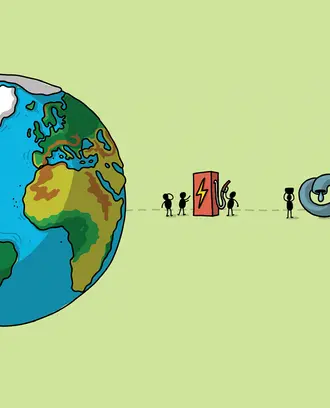Credit: Maclay Architects
For 40 years, iconic TV show “This Old House” has shown viewers how to elevate ordinary houses into thoughtful, livable refuges. The net-zero home of David Miller, MS ’91, PhD ’07, encapsulates that mission.
This season the cast visited Miller’s Newton, Massachusetts, home for inspiration before renovating a Rhode Island bungalow. They were impressed: Net-zero homes produce as much renewable energy as they use, and Miller’s home is a paragon of energy efficiency.
“Climate change is the biggest threat to our civilization this century. We have a moral obligation to the next generation,” Miller said in an interview. “Clean energy technology is part of the solution, and I want to walk the talk.”
Miller and his wife, Karen, designed the shingle-style home from scratch in 2011 on the site of an abandoned home in the town just outside of Boston. The family enlisted Vermont-based Maclay Architects, experts in net-zero design, to execute their vision.
The home is all electric and is powered by the sun. Rooftop photovoltaic panels generate electricity and solar thermal panels produce hot water. Heating and cooling are enabled by an air-source heat pump powered by electricity from the home’s panels. Solar inverters convert DC energy into AC energy used by the grid.
The home also boasts foot-thick walls insulated with eight inches of cellulose, often made from recycled materials. Miller hailed this as the most “ecologically sound” form of insulation. Many homes harbor air leaks, he said, letting warm air out and cold air in. With an R-value of 40 — a measure of how well insulation resists heat — his home is tightly packed.
“It’s an abundant material, very safe and healthy to put in the walls,” he said.
In a tightly packed home, ventilation is crucial. Miller’s house is outfitted with an energy recovery ventilation system, which keeps heat in during the winter while exchanging fresh air from the outside.
Windows face south, allowing for plenty of passive solar heating. At night, insulated Lutron intelligent shades automatically descend, keeping rooms warm overnight.
“On a sunny day in the winter, regardless of how cold it is outside, the sun by itself will heat the rooms,” Miller said in the This Old House episode.
People might perceive these structures as ultra-modern or non-traditional, Miller said — perhaps an issue in Massachusetts, where such homes wouldn’t blend with the Colonial character. Miller hopes to show audiences otherwise.
“People have this image of them being ‘space age’ or have an image that if you’re living with net zero or no impact, you’re living in a hut, off-grid,” he said.
But Miller lives in a suburban neighborhood with easy access to public transportation — which also allows him to drive less.
His living space is a natural extension of his career. Miller has long been on the forefront of the clean-tech industry. As co-founder and managing director of Clean Energy Ventures, he invests in companies commercializing disruptive clean energy technologies. Miller is also a founding member of the MIT Enterprise Forum’s Energy Special Interest Group. He continues to collaborate with MIT’s Sloan School, where he completed his dissertation, which focused on the impact of investment strategies and public policy initiatives on new clean energy ventures. As a research affiliate at MIT Sloan, he continues this work.
Miller joins other members of the MIT community with net-zero homes. Professor John Sterman, a member of the MIT Sloan System Dynamics group, retrofitted his 1928 Colonial revival in Lexington, Massachusetts, in 2015. So far, the home has produced over 50 percent more energy than it has used, with no fossil fuel. Mark Doughty, MBA ’99, president of noted high-end custom-builder Thoughtforms, also maintains an award-winning better-than-net-zero home.
“This Old House” was amazed by Miller’s ingenuity, and justifiably so.
“At our four-year mark, I checked the meter, and it was below where it was when we moved in. We’ve produced more energy over those four years than we’ve used,” Miller said.



